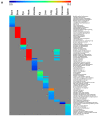Mouse Organ-Specific Proteins and Functions
- PMID: 34943957
- PMCID: PMC8700158
- DOI: 10.3390/cells10123449
Mouse Organ-Specific Proteins and Functions
Abstract
Organ-specific proteins (OSPs) possess great medical potential both in clinics and in biomedical research. Applications of them-such as alanine transaminase, aspartate transaminase, and troponins-in clinics have raised certain concerns of their organ specificity. The dynamics and diversity of protein expression in heterogeneous human populations are well known, yet their effects on OSPs are less addressed. Here, we used mice as a model and implemented a breadth study to examine the panorgan proteome for potential variations in organ specificity in different genetic backgrounds. Using reasonable resources, we generated panorgan proteomes of four in-bred mouse strains. The results revealed a large diversity that was more profound among OSPs than among proteomes overall. We defined a robustness score to quantify such variation and derived three sets of OSPs with different stringencies. In the meantime, we found that the enriched biological functions of OSPs are also organ-specific and are sensitive and useful to assess the quality of OSPs. We hope our breadth study can open doors to explore the molecular diversity and dynamics of organ specificity at the protein level.
Keywords: biomarkers; bone proteome; brain proteome; eye proteome; fat proteome; heart proteome; intestine proteome; kidney proteome; liver proteome; lung proteome; mouse proteome; organ proteome; organ-specific proteins; pancreas proteome; proteome diversity; proteome dynamics; skeletal muscle proteome; spleen proteome; testis proteome.
Conflict of interest statement
The authors declare no conflict of interest.
Figures







References
-
- Zhou Y., Qin S., Wang W. Biomarkers of drug-induced liver injury. Curr. Biomark. Find. 2013;3:1–9.
Publication types
MeSH terms
Substances
Grants and funding
LinkOut - more resources
Full Text Sources
Other Literature Sources

